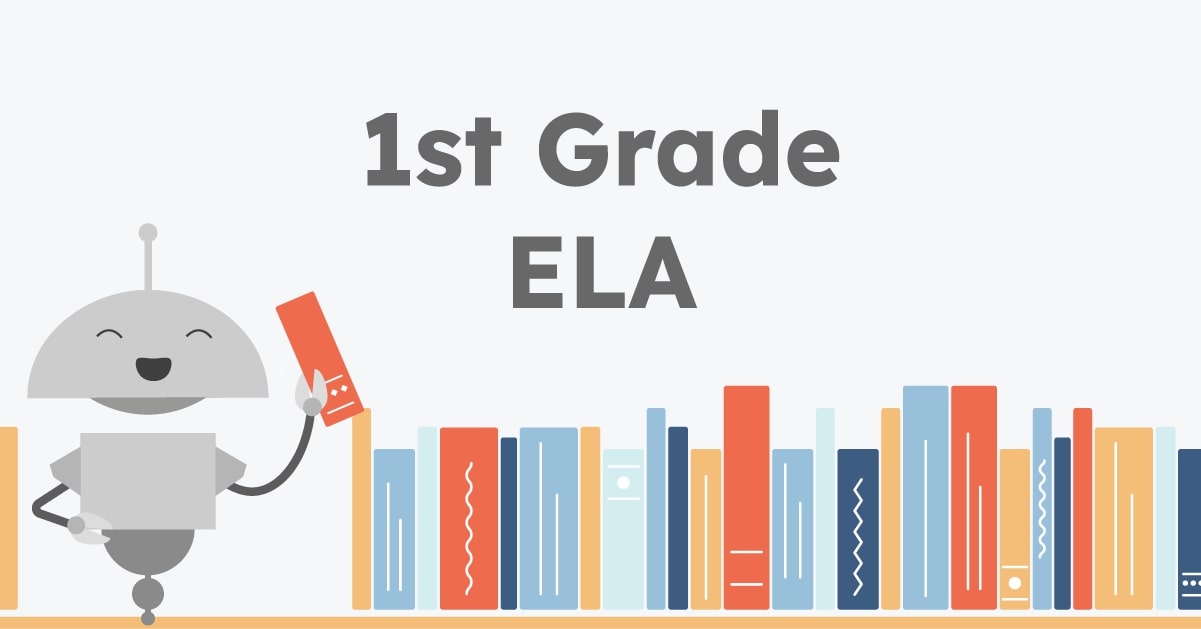1st Grade Language Arts Curriculum (ELA)
In first grade, students build on early literacy skills to become confident readers and writers! Whether they’re reading simple stories aloud, identifying the main idea in a passage, or writing short sentences, they’re strengthening the language skills they’ll use every day.
Our first grade language arts curriculum helps students develop key skills such as decoding words using phonics, reading with fluency and expression, understanding story structure, writing complete sentences, and using capital letters and punctuation correctly. They also begin to expand their vocabulary, recognize parts of speech like nouns and verbs, and express ideas clearly through writing and speaking. Mastering these skills builds a strong foundation for reading comprehension, creative writing, and effective communication.
Plus, Miacademy makes learning reading and writing fun and engaging! With interactive lessons, quizzes, and hands-on activities, kids practice essential literacy skills in an enjoyable and supportive way.
Sample Lesson
To explore more of what Miacademy has to offer, check out our sample lessons on Youtube! @TheMiacademyLearningChannel
Is my student ready for 1st grade language arts lessons?
In first grade language arts, students build on basic skills by strengthening their reading, writing, and communication abilities. They begin to read simple sentences, recognize sight words, understand basic phonics rules, and start using reading comprehension strategies. Their writing skills also grow as they begin forming complete sentences, using punctuation, and spelling common words.
If your child isn’t reading fluently yet, that’s okay! Look for signs of progress, such as an interest in stories, the ability to sound out words, and enjoyment of writing or drawing to express ideas.
Your student is likely ready for first grade language arts if they:
Free 1st Grade Language Arts Activities – PDF Download
Each video lesson has a PDF with engaging activities to extend learning beyond the screen with a hands-on approach!
Click here to download a free sample PDF of our first grade ELA worksheets:
What do 1st graders learn in language arts?
By the end of the year, students will master first grade ELA standards such as:
- Phonics & Word Recognition – Decoding words using letter-sound relationships, blending sounds, and recognizing sight words
- Reading Comprehension – Understanding stories by identifying main ideas, characters, and basic plot elements
- Fluency – Reading simple texts aloud with accuracy and expression
- Writing – Using capitalization and punctuation to write short sentences
- Spelling & Vocabulary – Expanding word knowledge through phonics patterns and high-frequency words
- Grammar – Learning parts of speech like nouns and verbs
- Speaking & Listening – Expressing ideas clearly, participating in discussions, and listening to stories or instructions attentively
Scope and Sequence
Learn to Read: Level B
Our Learn to Read: Level B course helps students strengthen their reading foundation by reviewing consonant sounds, learning short and long vowel sounds, and blending sounds to decode CVC words. They will develop key literacy skills such as auditory blending, sight word recognition, understanding word families, identifying vowel pairs, and understanding complex sounds.
Students will also practice identifying and isolating sounds in words, reading and spelling CVC words, and understanding syllables. Additionally, they will learn basic sentence structure, including nouns, verbs, capitalization, and punctuation. By the end of the course, students will have strong decoding skills and the ability to write simple sentences confidently.
Language Skills: Level B
In Language Skills: Level B, students expand their word knowledge and develop foundational grammar skills. They will learn to write complete sentences with nouns and verbs, use correct capitalization and punctuation, and understand basic grammar concepts like synonyms and antonyms. Throughout the course, students will practice reading and writing simple sentences and progress from writing a one-sentence story to a two-sentence story. By the end, they will confidently apply these skills to build clear and structured sentences.
Why is there more than one course?
Miacademy’s language arts curriculum is structured into three different courses, each that focus on a different set of skills:
Learn to Read (Levels A-C only): Focuses on letter sounds, rhyming, and common letter patterns to help kids practice reading for kindergarten to 2nd grade.
Language Skills (All levels): Covers comprehension strategies, grammar, and storytelling techniques to strengthen reading and writing.
Reading Comprehension (Levels C-I only): Provides weekly reading passages with questions to reinforce understanding and apply learned skills.
Students may work at different levels in each area to match their individual learning needs.
Miacademy’s Online 1st Grade Homeschool Curriculum
Our ELA curriculum goes beyond just reading and writing — it’s about mastering communication, thinking critically, and expressing ideas with confidence and creativity.
Our K-8 courses use inquiry-based learning to encourage curiosity, guiding students to analyze texts, ask thought-provoking questions, and engage on a deeper level with their reading. Designed by experienced educators, our lessons nurture both confidence and curiosity, helping students develop strong literacy skills they’ll use throughout their lives.
One of the best things about homeschooling a first grader with Miacademy is the flexibility! You get full customization over your lesson plans and assignments to fit your child’s unique learning needs. They can skip what they already know and dive right into new challenges!
Miacademy has so much to offer — our family of accredited curricula covers everything from learning to read to studying literature, growing and adapting along with your child’s educational needs. Whether you homeschool full time or are looking to supplement a public school education, we’re here to support you! Wondering if Miacademy’s homeschool curriculum can be a good fit for your student? Start a chat with one of our friendly customer service agents below! They’ll be happy to help you with any questions you may have.



